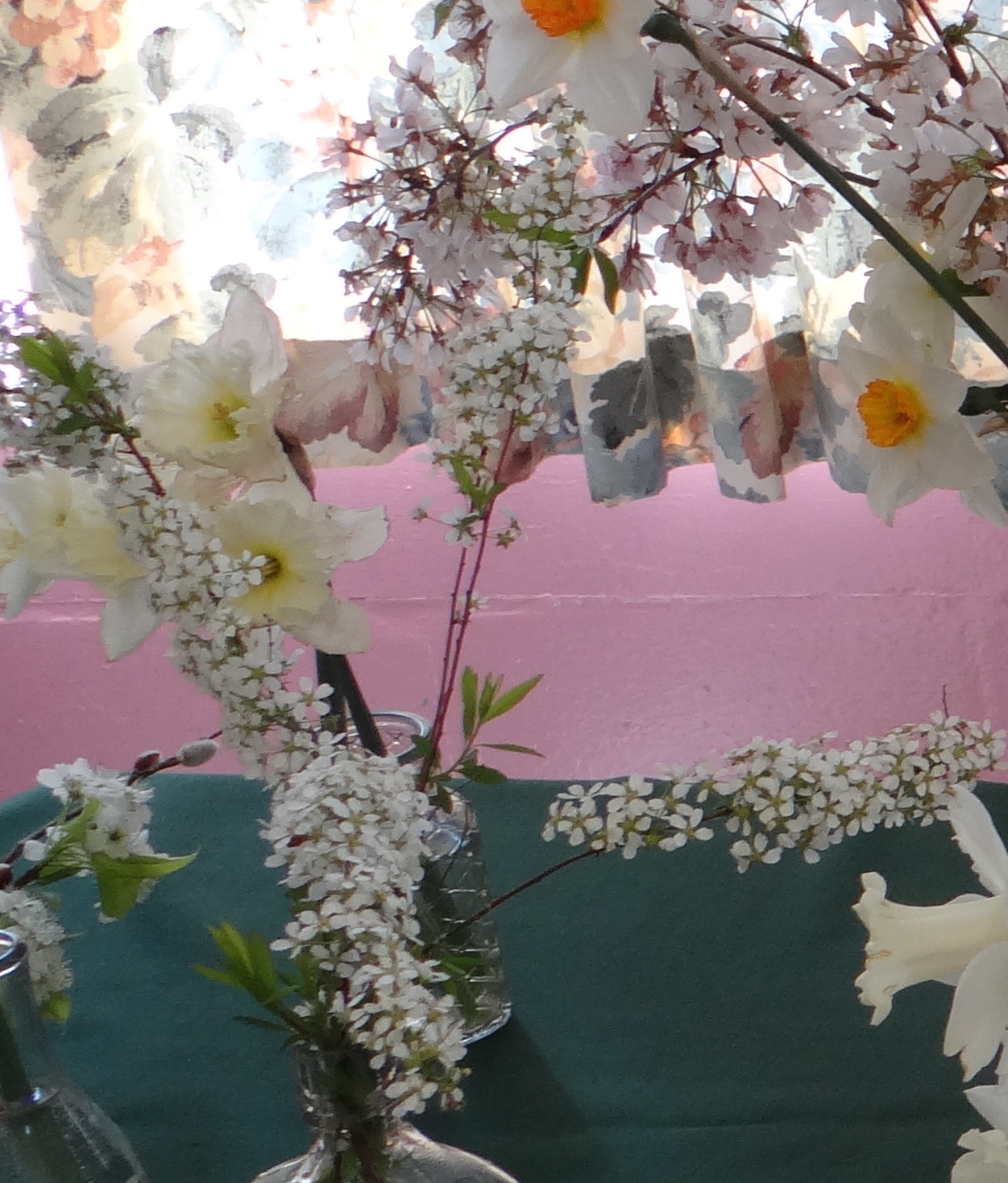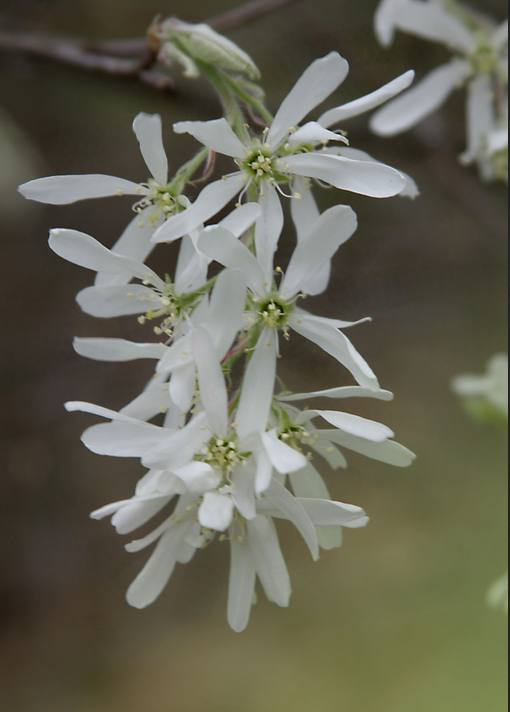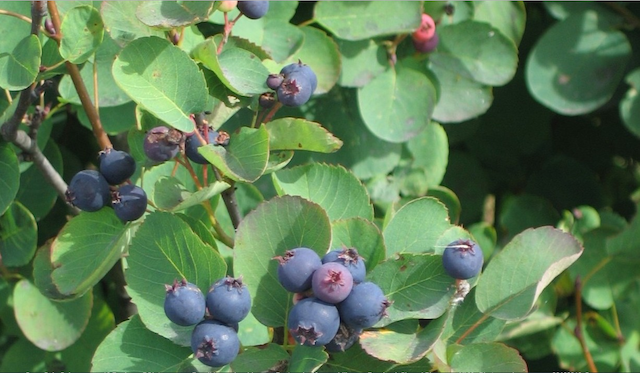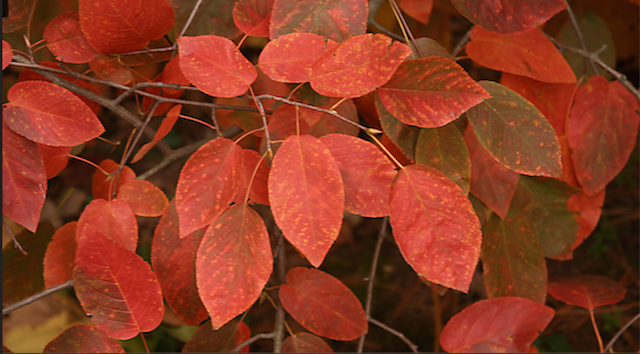Someone may have brought Amelanchier to the White table at the meeting, so a suggestion was made to do a post about them.
We know Amelanchier (Am-uh-lan-sheer) under many different names, the most familiar to us being;
- Shadbush or Shadblow–likely New England source since it blooms about the time the fish, Shad, run.
- Juneberry–typical time the fruit is ripe
- Saskatoon–Cree Indian derivation, one of the berry ingredients of pemmican.
- Serviceberry–due to similarity to English sorbus (and some folklore about church services timed to bloom)
One reason is that Amelanchier is native to both Canada and every state but Hawaii, but there are many species that have adapted to the varied growing conditions from eastern to western climates and soils and can grow in zones from 4-9. So, we have A. canadensis which is eastern; A. alnifolia of Alaska,the Pacific and the Great Plains; A. arborea, and A. laevis (Allegheny) are both east of the Mississippi R. They will freely hybridize.
The group of serviceberries run the gamut from small trees (30 ft tall x 20 ft wide max) which can be multitrunked, to suckering shrubs that may form colonies. Depending on the species, they may prefer successional habitats (cleared land or land returning native) or understory conditions.
The flowers, borne in masses, are slightly fragrant, white to pink blushed in drooping clusters at branch tips. Some hybrid cultivars with the “x grandiflora” (Autumn Brilliance, Princess Diana) have larger showier flowers than the pure natives. As an early bloomer, Amelanchiers provide nectar to pollinators when other sources are scarce.
Next, come the berry-pome clusters which turn from green to pink to purple to black in clusters of up to 12, ripening pretty much at the same time. The berry size ranges from 1/4 to 5/8 inch. As one of the first of wild summer fruits, birds are drawn in droves to strip the trees. For anyone wanting to attract bird life, this would be a prime planting. These birds especially enjoy the fruits: catbirds, grosbeaks,cedar waxwings, orioles, brown thrashers, mockingbirds, thrushes, goldfinches, titmice, bluejays, chickadees, cardinals, robins, bluebirds, tanagers, towhees, juncos, grouse and pheasants.
Humans also enjoy the blueberry like flavor of particular species and cultivars straight from the bush, or picked to use in pies, jams and jellies, to make wine or for canning–especially from the A. alnifolia group. Commercial growers are more often found in the Great Plains areas where this grows as a large shrub, tolerating the alkaline conditions. Up to 10 pounds per plant can be harvested. These berries have been tested for nutrients and have been found superior to blueberries or strawberries. The commercial growing is subject to losses from frosts during bloom time or from birds, so the devoted acreage is not large compared to other fruits.
Amelanchiers also sacrifice their twigs and leaves to wildlife and are therefore used for game land restoration and wildlife plantings. Out west, moose, elk, mountain sheep and deer will browse the foliage. In the wild, the pressure of rabbits and deer can suppress regeneration of serviceberries when too heavily browsed. Chipmunks, squirrels, bears and beavers will also eat berries. Butterflies like Red Admiral caterpillars eat the leaves too. We can enjoy the colorful fall foliage. Depending on the species or cultivar, the leaves turn yellow, orange or brilliant red.
Winter reveals lovely silvery gray bark. Landscapers suggest a dark backdrop like evergreens to best enjoy all four seasons of interest.
Growing serviceberries depends on where you live. As mentioned above, in the Eastern states, we are most likely to encounter, A. canadensis/laevis/arborea and their cultivars. These are adapted to acid to neutral soils and do best with sun to part-sun condition. Amelanchier is quite tolerant to many conditions, expresses itself best in loamy (humus) soil that drains well. They appreciate being kept moist so as not to suffer drought-like conditions. Like other plants in the Rose family, they can be plagued with rust, fireblight and borers. Otherwise, they are low maintenance. Pruning is done in autumn. Cuttings can be taken in summer.
Amelanchier shines as a windbreak, hedge or naturalistic, native planting scheme such as those for attracting wildlife. The small trees do well in modern suburban yards or as understory trees.
These are links to some blogs with pictures showing Amelanchier used in the landscape:
In the landscape:







3 comments for “Serviceberry–the Giving Tree”